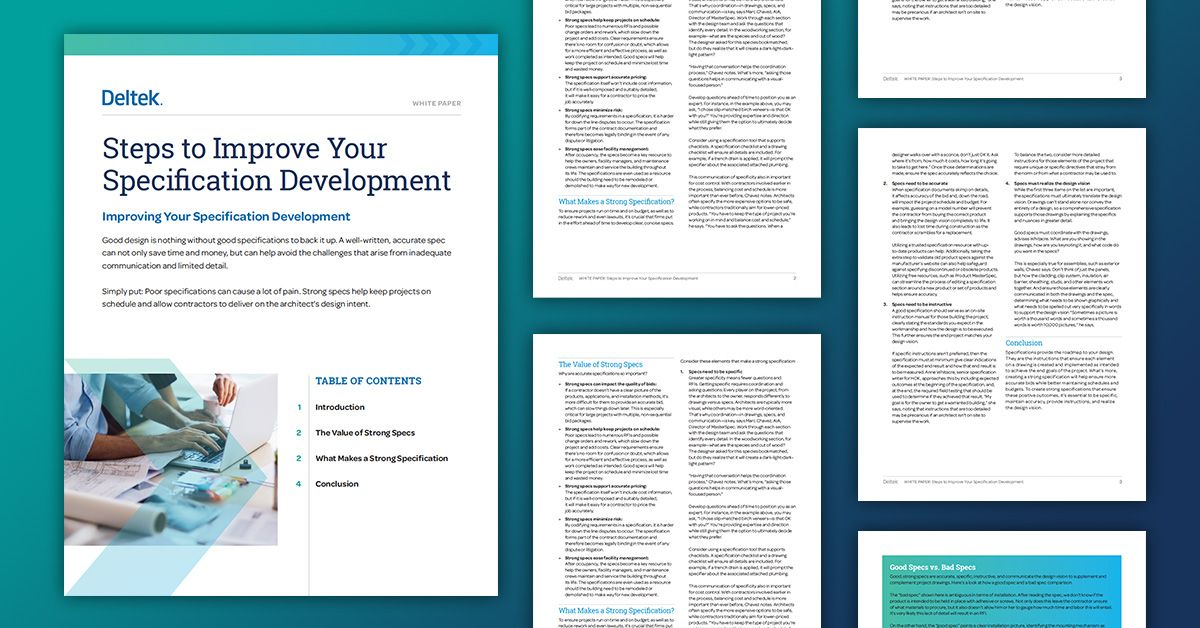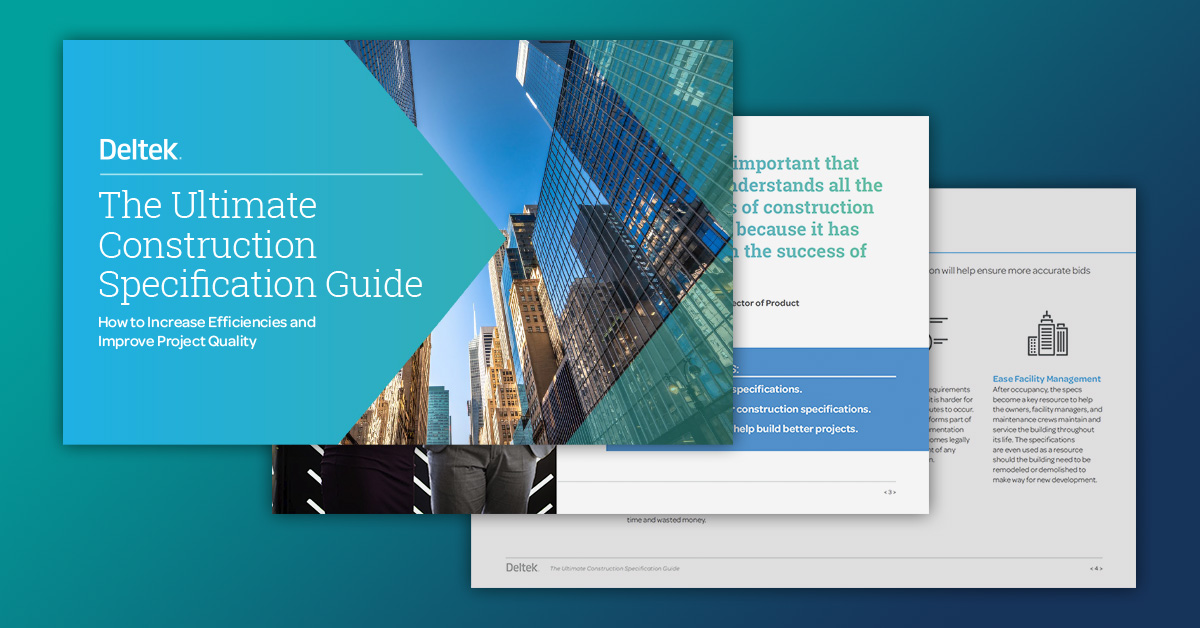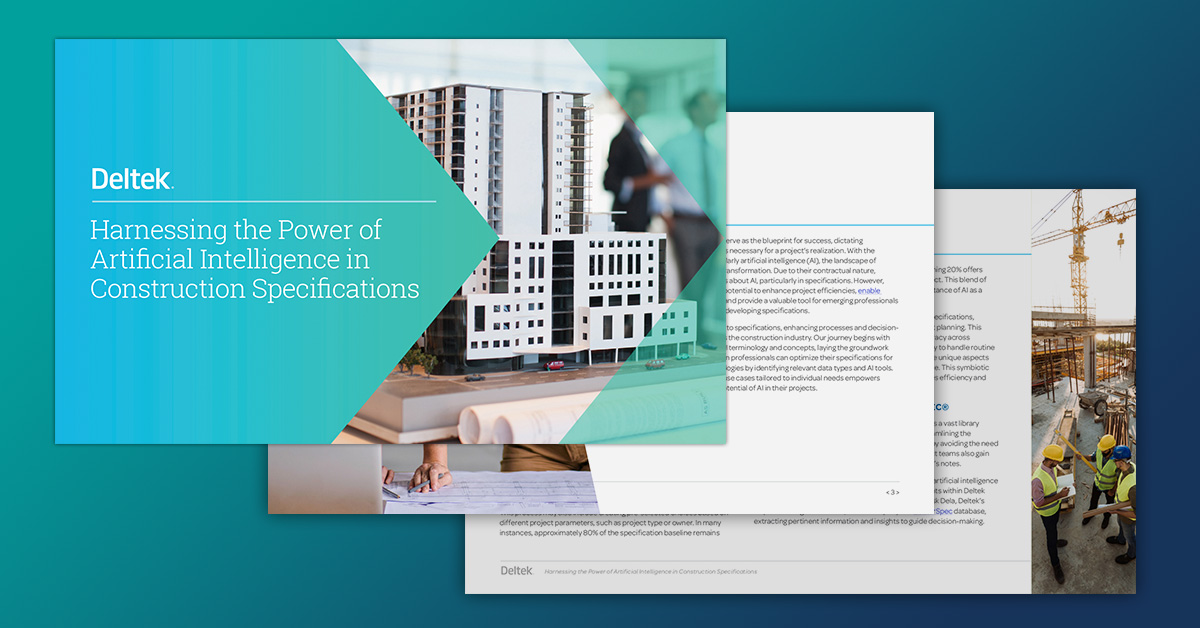What Are Construction Specifications? A Comprehensive Guide
When architects and engineers bring a project to life, they rely on more than drawings to guide their vision. Construction specifications are critical to project documentation, spelling out what materials contractors should use, how the work should be performed, what quality is required, and which standards to meet.
This guide explores how specs complement drawings and supports project success by improving performance, reducing errors, and enhancing coordination.
What are Construction Specifications?
Construction specifications, often shortened to "specs," are detailed written instructions that supplement drawings by defining exact requirements for materials, workmanship, performance expectations, installation methods, and compliance standards. Used alongside architectural and engineering drawings, they translate design intent into unambiguous construction directives, ensuring quality, consistency, and legal alignment across all stakeholders.
Types of Construction Specifications
Construction specifications typically fall into four primary specification types, each offering distinct advantages that can maximize project outcomes. Understanding these different specification types allows architects and engineers to select the most effective approach for each building system, balancing control, innovation, consistency, and industry standards.
1. Prescriptive Construction Specifications
Prescriptive specifications provide explicit details about materials, products, and installation methods required for a project.
- Detailed Requirements: Outline exact materials, brands, and installation techniques
- Quality Control: Maintain consistent standards and facilitate bid comparison
- Best For: Standard building elements or matching existing materials in renovations
- Limitation: May limit innovation and alternative solutions
Overall, prescriptive specifications offer clear guidance and quality assurance but may limit flexibility in design and construction approaches.
2. Performance Specifications
Rather than specifying exact materials or methods, performance specifications define expected outcomes and functional performance requirements.
- Outcome-Focused: Establish measurable criteria for how finished work must perform
- Innovation Opportunity: Allow contractors to propose innovative, cost-effective solutions
- Best For: Complex systems or rapidly evolving technologies
- Consideration: Requires more testing and verification to ensure outcomes meet criteria
By focusing on performance rather than specific types of materials, these specifications encourage flexibility and technological advancements in construction.
3. Proprietary Specifications
These specifications mandate specific brands or products for consistency, quality, or compatibility.
- Exact Product Designation: Name specific manufacturers and models without substitutions
- Best For: Matching existing installations or when owners have standardized on certain products
- Limitation: May limit competition and potentially increase costs
- Legal Note: Public projects often restrict proprietary specifications unless alternatives are allowed
Proprietary specifications can streamline the building process by ensuring consistency and reliability, though they may also impact cost and competition.
4. Reference Standard Specifications
These rely on established industry standards and codes, such as those of the American Society for Testing and Materials (ASTM) or the International Organization for Standardization (ISO), to ensure compliance with recognized benchmarks.
- Industry Benchmarks: Incorporate consensus-based requirements representing best practices.
- Verification: Include established testing methods and acceptance criteria
- Best For: Common construction elements with well-established industry practices
- Consideration: Must carefully manage which version of standards apply to avoid conflicts
Most projects use combinations of these specification types, selecting the appropriate approach for each building system based on project goals, risk considerations, and market conditions.

Best Practices to Enhance Drawings and Specifications
Discover five best practices to ensure your drawings and specifications match and increase your project success.
Key Components of Construction Specifications: Real-World Benefits
Well-structured construction specifications deliver tangible advantages through several key components, each offering specific benefits for architects, engineers, and project stakeholders:
Prevent Costly Disputes and Work Stoppages
Well-defined project scope and objectives create clarity that prevents conflicts before they begin. When a scope dispute arises, having clear documentation prevents costly work stoppages. Instead of multiple meetings and potential litigation, team members can reference the specifications for immediate resolution.
Protect Design Integrity and Performance
Detailed material, product requirements, and construction methods faithfully execute your design vision and engineering criteria. Comprehensive specifications enable sourcing exactly the products and materials the designers selected, preventing substitutions that compromise design integrity. When the concrete contractor knows precisely which mix design is required, they don't need to make last-minute decisions that could affect structural performance or aesthetic qualities.
Eliminate Expensive Rework and Reinstallation
Clear workmanship standards in construction specs set expectations for quality that prevent costly corrections. When mechanical contractors have precise specifications for ductwork installation, sealing requirements, and testing protocols, they can complete the work correctly the first time.
Catch Problems Early Before They Become Costly Failures
Comprehensive testing protocols in project specifications identify issues when they're still inexpensive to fix. These requirements catch defects during construction when remedies are simple and affordable—not after occupancy when a rainstorm reveals leaks that cost thousands to repair.
Ensure Code Compliance and Pass Inspections the First Time
Detailed regulatory guidelines create a roadmap for successful code compliance and approvals. MasterSpec—the industry's leading specification system from AIA—provides a comprehensive Table of Contents to ensure thorough coverage of all building code requirements. When documentation specifies fire-rated assembly requirements, installers follow precise instructions without guessing or making assumptions. Clear specifications prevent dangerous non-compliant installations and eliminate situations where inspectors reject work and require costly corrections.
Maintain Project Momentum and Prevent Scheduling Delays
Structured submittal procedures keep the project timeline on track by preventing procurement bottlenecks. Clear submittal requirements mean the curtain wall manufacturer can prepare and submit samples and shop drawings at the right time in the project sequence. Proper documentation eliminates the lengthy delays that commonly occur when teams fail to properly document and approve critical long-lead items.
Comprehensive specifications create a responsive framework that keeps projects moving efficiently. When questions arise—as they inevitably do—teams don't need to stop work and wait for clarification. Instead, they can quickly reference the specifications and continue working, maintaining momentum and preventing the cascade of delays that typically follow when production halts. From preventing rework to streamlining procurement, well-developed specifications are the essential framework that keeps projects running smoothly from concept to completion.

Guide to Writing Accurate Construction Specifications
Strong specs keep projects on schedule. Start writing better specifications today with these tips from expert spec writers.
Common Challenges Using Construction Specifications
Even the best-written construction specifications can run into roadblocks during a project. Here are some of the most common challenges—and how to avoid them:
1. Vague or Ambiguous Language
Phrases like “high quality” without measurable criteria often lead to confusion, disputes, or extra costs. Clear, precise wording helps ensure everyone interprets requirements the same way.
2. Inconsistent Terminology
When different sections of a specification—or related project documents—use conflicting terms, it creates uncertainty about what’s required. This can slow down progress and trigger costly corrections.
3. Poor Version Control
If specifications are updated without a reliable system for tracking revisions, outdated documents may end up on the jobsite. This increases the risk of mistakes, delays, and rework.
4. Falling Behind on Codes and Standards
Building codes and industry standards change frequently. Specs that don’t reflect the latest requirements can lead to delays and problems.
5. Gaps Between Specs and Drawings
When specifications and construction drawings don’t align, contractors often submit Requests for Information (RFIs) to clarify requirements. These RFIs, along with change orders, can delay schedules and increase project costs.
Best Practices to Overcome These Challenges
To keep projects on track, teams can:
- Write specifications in clear, measurable language.
- Use consistent terminology across all documents.
- Implement a version control system to manage updates.
- Regularly review specs against current codes and standards.
- Establish cross-referencing and coordination protocols between specs and drawings.
By addressing these issues upfront, construction teams can reduce RFIs, avoid costly disputes, and deliver projects more efficiently.
Construction Specifications vs. Drawings: Understanding the Difference
Specifications and drawings complement construction documentation, each providing unique information critical to successful project delivery. Understanding their distinct functions and relationships helps teams navigate conflicts and communicate clearly.
Drawings provide visual representations that communicate spatial relationships, dimensions, locations, and quantities, effectively illustrating the design intent. They answer questions like "where," "how many," and "what size." Through plans, elevations, sections, and details, drawings show the physical arrangement of building elements and their geometric relationships. However, drawings have limitations—they cannot effectively convey material quality requirements, performance standards, or execution methods.
Specifications, by contrast, deliver detailed written requirements that describe the quality standards for materials and workmanship. They answer questions like "what type," "what quality," and "how installed." Specifications define acceptable products, require specific testing, detail installation procedures, and establish quality standards that drawings cannot efficiently communicate through graphic means. Industry-standard resources like AIA MasterSpec® provide architects and engineers with comprehensive specification templates that ensure consistent coverage of critical requirements while allowing customization for project-specific needs. They provide the narrative context that gives meaning to the visual information in drawings.
The relationship between these documents is symbiotic:
- Drawings show what goes where
- Specifications explain what it is and how it's installed
Proper coordination between specifications, drawings, and the design team is essential for project success. When teams develop these documents in isolation, contradictions often emerge during construction, leading to requests for information, change orders, delays, and disputes. Implementing best practices for aligning drawings and specifications dramatically reduces issues while improving project outcomes. These practices include simultaneous development of drawings and specs, consistent cross-referencing, regular coordination reviews, and clear responsibility assignment. These integrated approaches to document production, where design and specification teams collaborate closely, help ensure consistency and completeness across all construction documents—ultimately reducing errors, minimizing RFIs, and delivering more successful projects.

The Ultimate Guide to Construction Specifications
Discover five specification best practices that can have a significant impact on the success of a project.
Innovations and Trends in Construction Specifications
As new technologies and methodologies evolve in the architecture and engineering industry, they transform how teams develop and implement specifications, driving significant improvements in efficiency, collaboration, and project outcomes.
BIM (Building Information Modeling)
Digital specifications integrated into BIM systems enhance coordination and reduce errors. The connection between 3D models and specification data creates a single source of truth where changes in one automatically update the other. This integration enables real-time clash detection, quantity takeoffs linked directly to specified products, and improved visualization of selected elements.
Sustainable Building Standards
Green building certifications, such as LEED, WELL, and Passive House, are increasingly shaping modern specifications. Putting sustainability into practice requires detailed performance criteria for energy efficiency, indoor air quality, material sourcing, and waste management. Specification writers now incorporate specific language to document compliance pathways, product transparency requirements (Environmental Product Declarations, Health Product Declarations), and performance testing protocols. This evolution has transformed specifications from simple material descriptions to comprehensive sustainability roadmaps.
AI and Automation
The architectural industry stands at a crossroads as AI begins to reshape workflows. According to AIA research, AI adoption in architecture is still emerging, with larger firms leading implementation. While only a small percentage of architects currently use AI regularly, many firms are actively exploring its capabilities, particularly among younger professionals and project architects. Artificial intelligence tools are now capable of generating specification drafts, checking for conflicts between documents, and identifying potential errors—dramatically reducing the time required for these traditionally labor-intensive tasks.
Forward-thinking firms are discovering how cloud-based specification software with built-in AI assistance can reshape this landscape. Deltek Specpoint exemplifies this evolution, delivering instant answers and insights through AIA MasterSpec® and supporting documents. This advancement marks a fundamental shift in how specifications are developed, moving from time-consuming manual processes to enhanced workflows that complement architect expertise.
Cloud-Based Collaboration
Online specification software such as Deltek Specpoint, Home of AIA MasterSpec® ensures that all regulatory requirements, including compliance with industry standards, are accurately reflected in the documents and adhered to throughout the project lifecycle, helping to avoid costly fines and project delays. Version control features to track all changes, while pre-written specification sections, templates, and automated workflows standardize and accelerate the process. By aligning specifications with customer expectations, project teams can deliver high-quality, on-time, and on-budget projects that meet or exceed client requirements. With the proper practices and tools in place, accurate project documents, including architectural specifications, drive success, enhance client satisfaction, and provide a competitive edge in a crowded market.
“Deltek Specpoint streamlines specification development and seamlessly integrates AIA MasterSpec, making it the ideal choice for modern architectural firms.” - Megan Scott, Architect, AG Architecture
These innovations pave the way for greater precision, sustainability, and adaptability in construction projects. As technology advances, specifications evolve from static documents into dynamic, intelligent systems that contribute to project success through improved accuracy, coordination, and knowledge management. These advancements enhance decision-making and streamline workflows when integrated early in the design phase.
Enhance Project Outcomes Through Quality Documentation
Construction specifications ensure quality, efficiency, and compliance in building projects. By maintaining clear, detailed, and up-to-date specifications, construction professionals can improve project outcomes, reduce risks, and foster better collaboration. Adopting best practices and leveraging technological advancements will further enhance the accuracy and effectiveness of construction specifications.

AI-Powered Specifications: The Future of Construction Documentation
Discover how AI can transform construction specifications in this essential guide. Learn practical strategies for leveraging technology to enhance efficiency and project outcomes.
Frequently Asked Questions
Construction professionals can find answers to their most common questions about documentation requirements below.
What are construction specifications, and why are they necessary?
Construction specifications are detailed written documents that define the materials, products, workmanship, quality standards, and procedures required to complete a construction project. They are necessary because they supplement architectural drawings, clarify project expectations, reduce ambiguity, ensure compliance with building codes, and help avoid costly disputes and delays. Specifications ensure all stakeholders work with the same understanding, improving communication, coordination, and project quality.
How do specifications impact project costs?
Specifications have a direct impact on project costs by influencing material choices, labor requirements, and construction methods. Clear and detailed specifications can prevent rework, reduce change orders, and improve bidding accuracy, helping control project budgets. Conversely, vague specifications may lead to higher costs due to misinterpretation, limited product selection, or unnecessary performance demands.
Who is responsible for enforcing construction specifications?
Enforcing construction specifications is typically a shared responsibility among the architect, project engineer, construction manager, and contractor. Architects and engineers ensure that the specifications reflect design intent and performance goals. During construction, the contractor must follow the specs, while project managers or third-party inspectors verify compliance through reviews, submittals, and site inspections. Ultimately, responsibility may vary by project delivery method and contractual roles.
How can I improve the clarity and accuracy of my construction specifications?
To improve clarity and accuracy in construction specifications, use standardized formats such as MasterSpec®, avoid vague language, and define all technical terms. Coordinate closely with drawings to eliminate conflicts, and regularly update specifications to reflect current codes, technologies, and materials. Implement peer reviews, version control, and automated specification tools like Deltek Specpoint to reduce errors and streamline development.

 Log In
Log In










